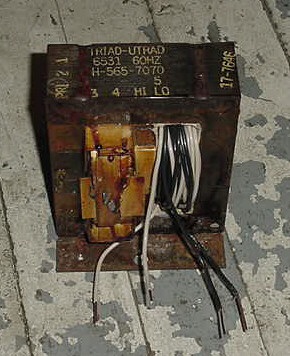The microwave transformer I rewound,
http://www.fieldlines.com/story/2005/11/7/135321/710 wound up being used as a homemade battery charger and has work fine until this morning. Let me back up some and explain the event since above post.

As discribed in previous post I wound up with two legs each producing about 13.5 volts DC after being rectified. For Identification I'll call the white pair Leg 1 and the black Leg 2. I mounted the transformer and to each leg attached a 25A bridge rectifier. Leg 1 I completed by running to short leads to + and - stainless steel studs compleate with wing nuts. To these I added to longer lead with battery clamps on the ends. While I did hook up a rectifier to Leg 2 that was all, it went unused til now. I also connected a small cooling fan from a computer PS 12V .15A to Leg 1. All is well and I have been using this to charge batteries with, with very good results the last time being last night.
This morning I had the bright idea to fixup my little charger and make it a really fancy dual output so I could either parallel the two legs for more amperage or charge two batteries at once. Enter Murphy's Law (If it works don't $%&^ with it) I should know better. I soldered on + and - outputs from Leg 2 to their own repective SS studs allowing me to hook another set of leads (for bat #2) if needed. I also ran jumpers to studs from Leg 1 (-) straight accross (+) thought a switch that could be switched on to parallel the two legs. Weeeelllll he we go. After completing all my fancy upgrades I decided to take some readings. Whooaaa what happened? Switch off (not paralleled) Leg 1 reads 10.13VDC Leg 2 reads 9.95VDC parallel them by turning switch on and the output is 9.99VDC. I disconnected all jumpers between Legs 1 and 2 voltage came up to about 11 on Leg one and 10 something on Leg 2. After puzzling for a moment I decided OK I'll just unhook everything and get back to where I was 13.5 Approx on Leg one. No such luck, I unhooked everything I did clear back to DC output on the rectifier on Leg 2, still get only 11.01 VDC from Leg 1 the same Leg I was getting 13.5 from earlier this AM.
What did I do :-( ? Now I can't even use the thing to charge a 12v battery.
By the way now that it doesn't work at all I intend on rewinding the whole thing with regular winding wire instead of Romex, but I still would love to know what the hell happened? Can someone explain!!!!
Wildbill